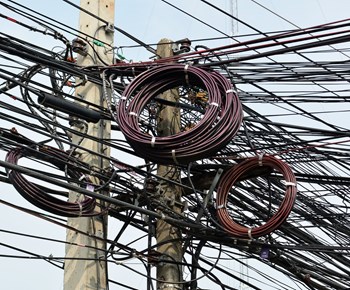How to Get Fios Installed in My Building

According to the city, not all households have FiOS (iStock).
Back in 2008 New York City granted a long sought-after and potentially-lucrative cable services franchise to Verizon Wireless for FiOS (fiber optic service). Thus, availability of FiOS to all New York City households was to be completed by June 2014.
Nearly two years later Verizon claimed it has "passed" all New York City households with fiber optic cable--something the city disagreed with.
The Issue
So what's the holdup? Sometimes it's a matter of semantics and other times logistics. In a letter sent by the NYC Department of Information Technology and Telecommunications (DoITT) to Verizon on September 13, 2016, Verizon had failed to "pass all households" in the city in deploying its FTTP Network. based on the letter, to "pass" each household is defined as to "run fiber immediately in front of or behind each residential building in the City."
Additionally, the letter continues that "Verizon is obligated 'to make Cable Service available to all residential dwelling units" in the City by accepting orders for service and then... installing all necessary equipment within the time frames afforded," which was 12 months. "As of October 9, 2015, there were at least 38,551" such requests, which were unfilled for more than twelve months.
For those readers who might be unfamiliar with the term, non-standard service requests are simply those that aren't a private house. A good graphic explanation can be found at here.
'Right-of-Way'
Ray McConville, a Verizon spokesman, says the problem is more complicated than it might seem. According to an article on arstechnica.com , in Staten Island where FiOS is available to upwards of 90 percent of residents, residences are primarily single family homes.
"Generally in a single-family neighborhood, where all the houses are basically suburban, you have aerial cable," says McConville. "The cable lines run down the street, which is easier to get to. When a customer requests FiOS, all we have to do is run a drop line from the nearest unit directly to the home and you're done. In an urban environment where it's all apartment buildings, the cable is all underground. The bigger challenge is getting 'right-of-way' access. People who live in apartment buildings don't have complete control over who can come in and out. The landlord or co-op or condo board has to give permission to enter." That's why only 11 percent of residents in upper Manhattan have access to FiOS currently.
The problem facing Verizon, explained McConville, is that they must obtain rights-of-way from each ownership entity leading from the corner of the intersection to each building down the block. In a sense it's like a game of dominoes. If your building is in the center of the block, the dominoes to either side of the street must agree before the fiber optic lines reach you.
The question begs itself as to why a landlord or co-op or condo board wouldn't simply grant a right-of-way to Verizon to make FiOS available, as there is no charge for the services to the building ownership. The answer lies in another term:, exclusive marketing agreements. An exclusive marketing agreement with another cable services provider may have been signed by the landlord or co-op or condo board in the past, which prohibits them from permitting another provider from accessing the property. Verizon claims that in many cases, "it is not enough for a co-op or condo board to say yes we want FiOS. We need permission from all the neighboring properties, some of which may have exclusive marketing agreements with our competitors. That's the challenge of providing FiOS to apartment settings."
Case In Point: Co-op City
An interesting turn of events on this problem was reported in the Daily News on January 22, 2016. Verizon claimed to have completed the "passing" of fiber optic cable to all neighborhoods. Yet according to the article, Verizon was accused of ignoring Co-op City because Co-op City has an exclusive marketing agreement with the incumbent cable provider in the Bronx.
"Despite our attempts," says McConville, "to work with the Co-op City board to install FiOS there, they recently granted the incumbent provider a ten-year extension of the exclusive marketing agreement. We remain open to talking with them in the future to work something out." At the same time the city's audit report of June 18, 2015 found that Verizon had demanded exclusive agreements from landlords themselves that would prevent other providers from servicing households in those same buildings.
It seems there's enough blame to go around on all sides for the delays. McConville says Verizon is committed to working with the city to complete the project. "All neighborhoods are FiOS ready. What's left to do is make all buildings FiOS ready. We plan to aggressively keep wiring buildings for FiOS."
A.J. Sidransky is a novelist and a staff writer for The Cooperator and other publications.
How to Get Fios Installed in My Building
Source: https://cooperatornews.com/article/whats-holding-up-citywide-fios-installation-throughout-nyc/full